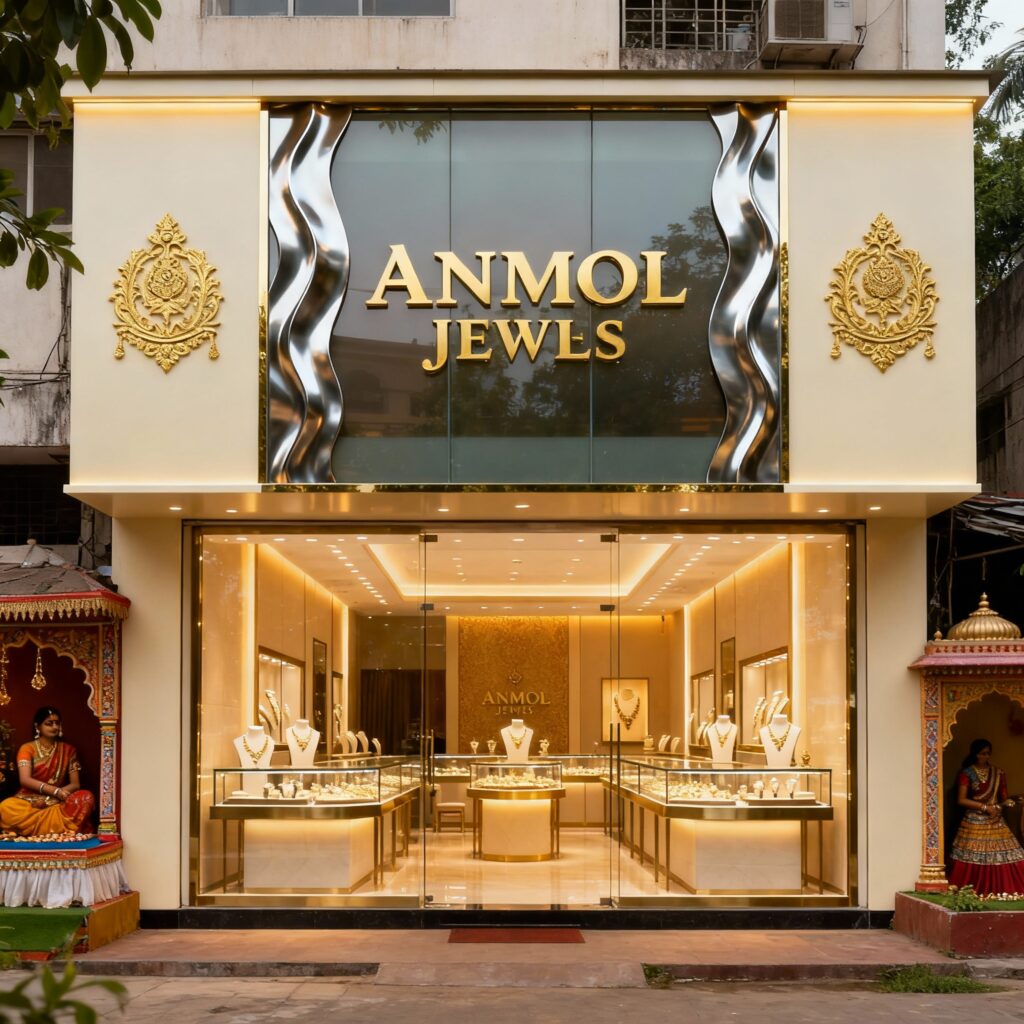
Introduction: The Importance of Facade Design in Luxury Retail
In the world of luxury retail, particularly for high-end jewelry boutiques, the facade serves as the first point of contact between the brand and its discerning clientele. A well-designed facade is not merely an architectural element; it is a powerful storytelling tool that communicates brand values, heritage, and sophistication. For jewelry boutiques, where every detail matters, the exterior design must embody the precision, elegance, and luxury that customers expect to find within. This is where parametric facade design emerges as a game-changing approach, allowing architects to create visually stunning and culturally resonant exteriors that capture attention and invite exploration.
Anmol Jewels: A Masterpiece of Parametric Facade Design
The Anmol Jewels boutique stands as a testament to the transformative power of parametric design in contemporary luxury retail architecture. This innovative jewelry boutique showcases a breathtaking wave-pattern facade that seamlessly blends modern design techniques with traditional Indian aesthetic sensibilities. The facade’s distinctive undulating form is not merely decorative; it represents a carefully crafted synthesis of materials, technology, and cultural symbolism.
The parametric facade design for Anmol Jewels features a mesmerizing metal wave pattern that creates a dynamic visual experience. This rhythmic, flowing design draws the eye and evokes associations with precious metals and fine craftsmanship—qualities intrinsic to the luxury Indian jewelry housed within. The wave pattern is achieved through precision-engineered metal panels that create depth, shadow play, and movement, transforming the building’s exterior into a kinetic sculpture that changes appearance throughout the day as light conditions shift.
Materials That Define Luxury: Smoky Glass and ACP Gold Embossing
The material palette for the Anmol Jewels facade was meticulously selected to convey luxury while maintaining functionality. The centerpiece of this design is the innovative combination of smoky glass with ACP (Aluminum Composite Panel) gold embossing. The smoky glass serves multiple purposes: it provides privacy for high-value merchandise while allowing natural light to filter into the interior spaces, creating an aura of mystery and exclusivity. The translucent quality of the smoky glass adds depth to the facade, working in harmony with the metal wave pattern to create layers of visual interest.
The ACP gold embossing is particularly significant in the context of a luxury Indian jewelry boutique. Gold holds profound cultural and emotional significance in Indian heritage, symbolizing prosperity, purity, and celebration. By incorporating gold-embossed ACP panels into the wave-pattern facade, the design creates an immediate visual connection to the jewelry displayed inside. These panels catch and reflect light in ways that mirror the sparkle of precious gemstones and the luster of gold jewelry, creating a cohesive brand experience that begins at the facade and continues throughout the interior.
The metal wave structure itself is composed of carefully formed panels that create a three-dimensional ripple effect across the facade. This undulating surface maximizes visual impact while demonstrating the technical capabilities of parametric design. Each wave crest and trough is precisely calculated to optimize aesthetics, structural integrity, and manufacturing efficiency.
Creating a Luxury Brand Experience Through Architecture
The Anmol Jewels facade accomplishes what every luxury jewelry boutique strives for: it creates an immediate sense of exclusivity and craftsmanship that resonates with high-end clientele. The parametric facade design establishes brand positioning before a customer even enters the store. The sophistication of the wave pattern, the richness of the gold embossing, and the enigmatic quality of the smoky glass work together to signal that this is not an ordinary retail space, but a destination for exceptional jewelry and refined taste.
The facade also performs a critical role in creating curiosity and desire. The dynamic interplay between solid metal, translucent glass, and reflective gold surfaces creates visual complexity that rewards closer inspection. Potential customers are drawn to examine the facade more closely, naturally leading them toward the entrance. This architectural choreography transforms passive passersby into engaged visitors.
Furthermore, the facade serves as an effective backdrop for evening illumination. When lit at night, the wave-pattern facade with its smoky glass and gold embossing becomes a glowing beacon, standing out in the urban landscape and reinforcing brand presence in the competitive luxury retail environment.
Connection to Indian Heritage Architecture
While thoroughly contemporary in execution, the Anmol Jewels facade design maintains a meaningful connection to Indian heritage architecture. The wave pattern can be interpreted as a modern abstraction of traditional Indian architectural elements such as jaali (perforated screens) and the flowing, organic forms found in temple architecture and Mughal design. The rhythmic repetition in the wave pattern echoes the intricate patterns found in traditional Indian textiles, jewelry designs, and architectural ornamentation.
The use of gold embossing is particularly resonant within Indian cultural context. Gold has been central to Indian jewelry making for millennia, and its incorporation into the facade creates a direct visual and cultural link to this heritage. The smoky glass, while modern in material and application, evokes the play of light and shadow that is a hallmark of traditional Indian architecture, where carved screens and strategic openings create dramatic lighting effects.
This fusion of contemporary parametric design techniques with traditional Indian aesthetic principles makes the Anmol Jewels facade culturally authentic while remaining distinctly modern—a balance that is essential for luxury Indian jewelry brands seeking to honor tradition while appealing to contemporary tastes.
Why Parametric Design Suits Jewelry Boutiques
Parametric design is particularly well-suited to jewelry boutiques for several compelling reasons. First, parametric design allows for the creation of complex, organic forms that would be difficult or impossible to achieve through traditional architectural methods. The precision and intricacy possible with parametric design mirror the craftsmanship found in fine jewelry, creating a natural conceptual alignment between the building and its contents.
Second, parametric facade design enables mass customization with controlled variation. Just as each piece of jewelry is unique yet part of a cohesive collection, parametric design can create facade elements that are individually distinct while maintaining overall design harmony. This was achieved in the Anmol Jewels wave-pattern facade, where each panel contributes to the unified flowing form while having its own specific geometry.
Third, parametric design excels at creating surfaces that interact dynamically with light—a crucial consideration for jewelry boutiques where sparkle, reflection, and luminosity are central to the product experience. The undulating metal wave pattern, combined with smoky glass and gold embossing, creates constantly changing light effects that echo the play of light on precious gems and metals.
Finally, parametric design communicates innovation and precision, qualities that resonate with customers seeking exceptional craftsmanship in their jewelry purchases. A parametric facade signals that the boutique values cutting-edge design and technical excellence, attributes that extend to the curation and quality of the jewelry collection inside.
Conclusion
The Anmol Jewels case study demonstrates the powerful potential of parametric facade design for luxury jewelry boutiques. Through the innovative use of wave-pattern metal panels, smoky glass, and ACP gold embossing, the facade creates a compelling luxury brand experience that honors Indian heritage while embracing contemporary architectural innovation. This project exemplifies how thoughtful facade design can elevate a jewelry boutique from a mere retail space to a landmark destination that embodies the artistry and prestige of the jewelry within. For architects and jewelry retailers seeking to create memorable, culturally resonant, and commercially successful boutique environments, parametric facade design offers a sophisticated solution that bridges tradition and innovation, craft and technology, heritage and modernity.


